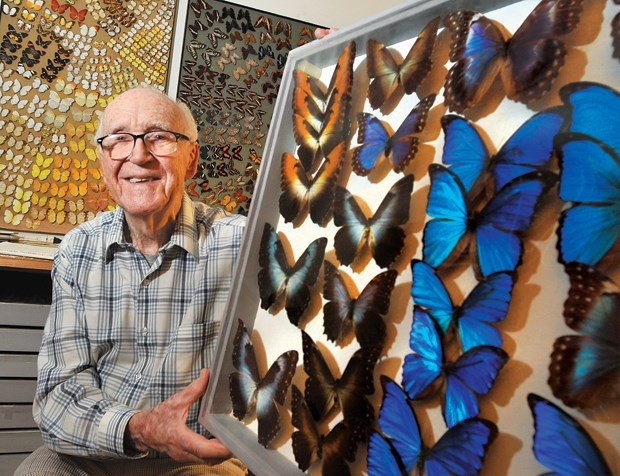His butterfly collection is rare, immaculate, and decades in the making.
“They are morpho from Brazil,” explained George Paclawsky, 90, as he pulled out a tray containing 25 perfectly preserved butterflies with brightly coloured, intricately patterned wings.
It’s just a sample of his magnificent collection, which contains 600-plus specimens, mostly from South America.
Born in the Ukraine, Paclawsky moved to Argentina to work in 1946, shortly after the Second World War, when he was 21.
There, he fell in love with a beautiful young woman named Vera who became his wife. In South America, he discovered another passion: studying and collecting butterflies.
“I always loved nature, even as a little kid,” he said.
When his job took him to Brazil, his penchant for butterflies grew.
“Because I liked nature I went to the Brazilian forest and I’d see these butterflies.”
Paclawsky picks up a notebook from a desk and pulls out a map of Sao Paulo that details every mountain and forest he travelled to in search of butterflies.
For every butterfly in the collection he has a journal entry recording the scientific name of the butterfly, sex, providence and date.
It’s a lifetime’s work. But recently Paclawsky decided to give it all away.
His beloved wife passed away three years ago and he began to worry about what would happen to his collection when he was gone.
“If the good God called me, these go to the garbage,” he said.
Paclawsky is a member of the Lepidopterists’ Society, a group dedicated to the study and appreciation of moths and butterflies, and one of its members inquired about buying his collection.
Paclawsky wasn’t interested.
“I want the butterflies to go to some public place,” he replied.
So with the help of some friends – he doesn’t have an Internet connection, he explained – Paclawsky began contacting Canadian universities and museums to find out if there was any interest in his prized collection.
“Everything goes. I donate the whole story.”
The University of Calgary’s Museum of Zoology called back.
On Thursday, John Swann, manager of the invertebrate section of the museum, arrived to Paclawsky’s Seymour area apartment to collect the collection.
When Swann first heard about the rare butterfly collection in North Vancouver he was intrigued.
His museum began acquiring private collections in 2009, and averages three or four new additions each year. The museum has 1.5 million-plus specimens valued at approximately $8 million.
When he pulled out the first tray of Paclawsky’s collection, Swann was stunned.
“Quite frankly it’s the best private collection I’ve ever seen. I’ve seen a lot,” he said. “The people that told me about it are very reputable themselves but even what they said about it doesn’t do it justice.”
After looking at the first tray, Swan said to himself, “It can’t all be like this, because it’s just immaculate.”
“I just kept pulling out more drawers… it’s just stunning.”
But it’s not just the beauty of the butterflies that had Swann so excited.
“It’s a case of it has all the scientific data with it. It’s absolutely immaculately prepared. There’s no tatters on the wings or anything like that,” he said. “If you’re trying to document biodiversity, all the seasonality data, all the location data. It’s just unbelievable in terms of education and outreach.”
Swann said another private collection donation a few years ago – coincidently also from North Vancouver – that contained butterflies from Southeast Asia is “a very close second to this.”
“It’s the perfect bookend to George’s collection. Suddenly we have stuff from around the world that’s for education and outreach. I do a lot with school groups. This stuff will just floor children. It’s that age you want to inspire kids about nature.”
Swann is appreciative of the donation, knowing that the butterfly collection could easily have been sold privately.
In the late-1980s, Swann attended a butterfly and insect auction in Toronto with his mentor and watched as showy specimens got snapped up. “It was crazy money.”
“It was dirt common stuff, George’s… this is the scientific stuff so it has a double-whammy of value. It’s that esthetic showmanship, yet it’s scientifically significant.”
Swann added, “To me it’s the consummate sort of immigrant story of someone wanting to give back to their adopted country. And this is a huge return for that sort of welcoming of a person to Canada. This is an incredible resource.”
Asked about his fascination with butterflies, Paclawsky paused for a moment.
“I don’t know, because the beauty of them, then I started to buy books.”
When he and his wife arrived in North Vancouver in 1996 the first thing he asked: “What kind of butterflies do we have in Canada.”
Soon, he added a book on B.C. butterflies to his collection and started hiking around Cypress, Grouse, Seymour mountains to observe Canadian butterflies.
“There’s not another place like it in the world,” he said about North Vancouver’s backcountry.
When he hiked around the Lower Seymour Conservation Reserve area Paclawsky felt there should be more species of butterflies.
So he asked for permission to plant more flowers to attract butterflies and also bring in butterflies from Cypress or Seymour to let go there.
The area in now known as Butterfly Garden and Paclawsky and his longtime friend, photographer Ian Lane, have been honoured for their work propagating the local butterfly population there.
Before Swann arrived to pick up the collection, Paclawsky set aside a few butterflies to keep in his home.
“I will take a few butterflies for me, to stay with them,” he said. “I want it for a memory of the sweet days, just for me.”



